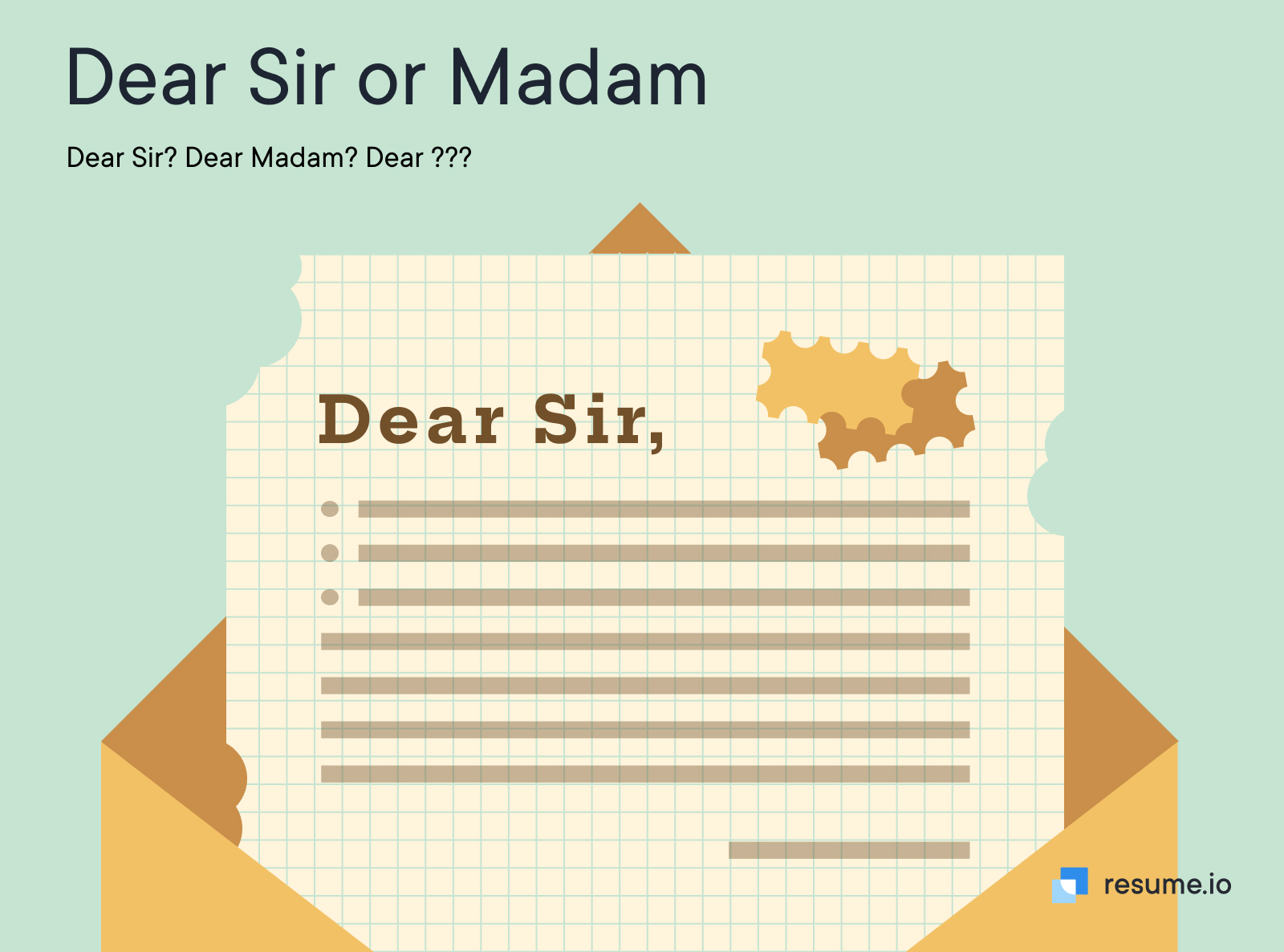As avid fans of The Crown or Downton Abbey can attest, there’s a time and place for addressing certain individuals out of respect as “sir” or “madam.” But the greeting of a cover letter is not one of them, now that we’re well into the third decade of the 21st century.
No one bats an eye when addressed as “sir” or “ma’am” (the “madam” contraction) by a polite restaurant server, sales clerk, police officer, or youngster. It’s a traditional courtesy for face-to-face stranger interactions that has survived shifting etiquette trends with little objection or suggested substitutes.
But you might expect an eye roll from recruiters on the receiving end of “Dear Sir or Madam” in a job applicant’s cover letter. That’s hardly the kind of first impression you want to make during those critical six or seven seconds that hiring managers normally spend deciding whether to read further.
How unfortunate to get bumped from the job competition, just because you started your cover letter with the off-putting address “Dear Sir or Madam” — especially if your cover letter is otherwise interview-worthy.
In this blog, we discuss:
- Is it ever okay for job seekers to use “Dear Sir or Madam” in a cover letter?
- Why this cover letter salutation is never advisable
- Much better alternatives to “Dear Sir or Madam” as a cover letter greeting

Is “Dear Sir or Madam” ever appropriate as a cover letter salutation?
The simple answer is no. There aren’t really any instances nowadays where it would be a good idea for job applicants to start a cover letter with “Dear Sir or Madam.” Not even for actors seeking roles in a Jane Austen adaptation!
Stopping short of a crusade for banishment from the HR vocabulary, let’s just say it’s always ill-advised to address your cover letter recipient as “Sir or Madam.” And considering the number of better alternatives, which we’ll look at later on, it’s never necessary.
Some variations you should also avoid:
- Dear Sir/Madam
- Dear Madam or Sir
- Dear sir and madam
- Dear Sirs and Madams
- Dear Sir or Madame

How did it come to this?
Not too many decades ago, opening any kind of business letter with “Dear Sir or Madam” was de rigueur. Older generations were taught that was the right salutation to use when the recipient’s name, job title, or gender is unknown.
Today, “Dear Sir or Madam” can still be an acceptable business letter salutation in extremely limited instances, even if less customary. But for job applications, it’s long fallen out of favor. It sounds old-fashioned, stuffy, impersonal, and strange, thus at odds with the way people normally speak to each other.
Our comments about the archaic connotations of “Dear Sir or Madam” apply only to the “Sir or Madam” part, not “Dear.”
“Dear” is still considered timelessly suitable for addressing any cover letter recipient, ideally by name, like this: “Dear Mr. [or Ms. or Dr.] [Surname].”
You’ll never go wrong with a “Dear” greeting. It strikes the right tone in sounding polite and professional, but also personable. There’s little risk of anyone taking offense, as long as you’ve double-checked the gender and name spelling.
As the digital age has found “Dear Sir or Madam” creeping closer to the edge of obsolescence, It’s become far less necessary to use this salutation as a workaround when letter recipients are unknown. Thanks to the internet — notably Google, LinkedIn, and employer websites — it’s much easier to attach a name and job title to the person you are addressing in a cover letter. Rarely will a job applicant’s online quest for this information be in vain.
The pitfalls of “Dear Sir or Madam”
On quite a few counts, a “Dear Sir or Madam” cover letter salutation sends the wrong message about your earnestness as a job applicant.
Above all, such a generic greeting comes across as lazy and unmotivated. It suggests you aren’t serious enough about this job to be bothered finding out who’s responsible for hiring decisions at the target organization. In fact, readers might perceive that you’ve made no effort to target the employer at all. Sending the same copied and pasted cover letter with multiple job applications is a readily spotted red flag for recruiters. Even if you’re not guilty of that infraction, “Dear Sir or Madam” could make you a non-starter when the reader is turned off right away.
Failure to tailor a job application to the specific hiring circumstance is a leading reason for recruiters to eliminate you from the candidate pool. Yet, 54% of job applicants do not customize their resume, or presumably their cover letter either.
A personalized cover letter greeting, on the other hand, can earn you instant points for professionalism and attention to detail. You also stand a better chance of a favorable response by addressing your cover letter recipient by name. At the very least, the reader is more inclined to perk up and pay attention to what you’ve written, and perhaps even reply with an acknowledgment.
There’s abundant scientific evidence that hearing or reading your own name has a mood-boosting impact when the brain releases the “feel-good” hormones serotonin and dopamine.
How could this fail to make a difference when your cover letter salutation addresses someone directly by name?
Here are a few more reasons not to use “Dear Sir or Madam” as your cover letter greeting.
- This outdated salutation might make you sound old-school and out of touch with the times.
- In the same vein, it’s not necessarily gender-inclusive in this day and age, when not everyone might identify as a “Sir” or “Madam.”
- As an impersonal and unnaturally formal way to address someone, “Dear Sir or Madam” has a distancing effect. This can hinder your effort to form a direct employer connection that gets off on the right foot.
- It shows a lack of initiative and resourcefulness. When the identity of your cover letter recipient could be just a few clicks away, or in response to a phone call or email inquiry, there are few excuses for not finding out who you’re writing to.
- The wishy-washy nature of “Dear Sir or Madam” could detract from the power of your cover letter language and impact overall.
Opening an email message with “Dear Sir or Madam” sounds even worse than starting a cover letter that way. With emails being more informal, this greeting seems all the more out of sync.
“Dear Sir or Madam” alternatives
As emphasized earlier, it’s always preferable to address someone by name in your cover letter greeting. And that should either be the hiring manager, or someone in a closely connected role, perhaps even the person you would report to on the job. When you’ve determined who that person is, it couldn’t be any simpler: “Dear Ms. Black,” “Dear Mr. Green,” or “Dear Dr. White” is the bullet-proof salutation that HR experts recommend.
In cases where someone’s gender is uncertain — perhaps the first name could apply to a male or female, or an initial is used instead — here are some possible salutations: “Dear Robin Gray,” “Dear T.J. Auburn” or even “Dear Mx. Teal.”
In some instances, it may be quite alright to use a less formal “Dear” substitute such as “Hello” or “Greetings.” But tread carefully here and make no assumptions. Unless you’re absolutely certain that the workplace culture is relaxed enough, err on the side of the failsafe “Dear” salutation.
As for using a first-name greeting instead of “Mr./Mrs./Dr. Surname,” it’s generally frowned upon. Keep in mind that a cover letter is still a business letter, however friendly and conversational the tone. Only if you happen to know the recipient personally would a first-name salutation be a good idea.
Also as stated previously, some online sleuthing, a phone call to the company receptionist, or an email to the general information address are your best bets for identifying the person you want to connect with directly.
But suppose you come up empty? Your search for a name, or even a position title, has been fruitless. Is it okay then to use “Dear Sir or Madam” as a last resort?
Further alternative options
No, it’s still not advisable or necessary to fall back on “Dear Sir or Madam” when you are unable to name your cover letter recipient. The same goes for the equally objectionable “To Whom it May Concern.”
Below are some friendlier and less generic options, adaptable to any situation. There’s room to further personalize by adding the company name, the job title, or a specific department, as applicable.
- Dear Hiring Manager
- Dear HR Manager
- Dear Human Resources Department
- Dear HR Team
- Dear Recruiter
- Dear Recruitment Team
- Dear Recruiting Manager
- Dear Audit Manager Recruitment Team
- Dear Networx IT Department Manager
- Dear Runners Fitness Program Coordinator
- Dear Sales Representative Hiring Manager
- Dear Marketing Director
- Dear Bandwagon Project Manager
Cover letter greetings along these lines demonstrate initiative, regard for detail and even creativity.
Key takeaways
- “Dear Sir or Madam” is never a good cover letter salutation because it’s outdated and impersonal. It also implies a lack of effort and interest on the job applicant’s part.
- Addressing the hiring manager by name is always the best way to start a cover letter. The internet has made it easier to find out who that person is, if not identified in the posted job ad.
- If it proves impossible to name your cover letter recipient, come up with a salutation that best fits the hiring circumstance. Greetings that address an appropriate manager, team, department, or position title are by far more effective than “Dear Sir or Madam” or “To Whom it May Concern.”






